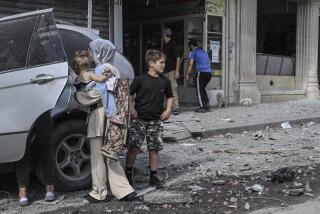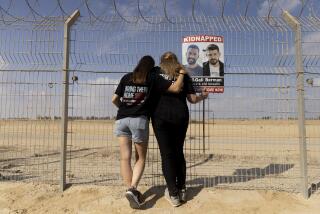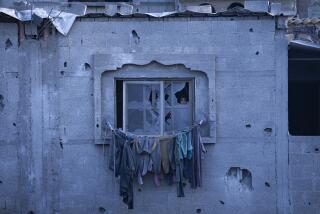New Index Rates Mideast Peace Process
- Share via
WASHINGTON — Hoping to do for diplomacy what batting averages do for baseball and the Dow Jones industrial average does for the stock market, UCLA political science professor Steven L. Spiegel has developed a scale for rating the Middle East peace process.
Spiegel said at a Capitol Hill news conference this week that on his 1-to-10 scale, the current peace index is 3.9--the lowest reading since the Gulf War year of 1991 and only a little more than half of the 6.9 recorded in October 1995, just before the assassination of Israeli Prime Minister Yitzhak Rabin.
What’s that? You say you knew things had gotten a lot worse in the past couple of months without having somebody put numbers on it?
Spiegel concedes that the index tends to “tell you what you already know.”
But he thinks the numbers, which he expects to issue every three months, will have a psychological impact on Israelis, Arabs and their U.S. mediators--much the way the Dow Jones affects economic policy, even though investors are pretty sure whether their stocks are going up or down without looking at the averages.
“This will affect the debate in Israel, surely,” Spiegel said. “I think it will have a similar impact on the Arabs.”
In an interview Tuesday, Secretary of State Madeleine Albright hailed the new index. “Americans are certainly familiar with the Dow Jones averages,” she said. “Anything that makes foreign policy understandable to Americans is a good thing.”
An ardent supporter of the peace process, Spiegel says he thinks his numbers will “subtly push things in a pro-peace process direction” by dramatizing just how good or how bad things are at any moment and by facilitating comparisons with events in the past.
Spiegel’s ratings are derived from seven quantitative categories: Israeli and Palestinian economic statistics, economic confidence in Israel, the extent of trade and tourism between Israel and Arab countries, political violence and Israeli and Palestinian public opinion surveys.
To flesh out those statistical reports, he uses a panel of Middle East experts to rate subjective categories like Palestinian-Israeli relations, the Syrian-Lebanese-Israeli relationship, Egyptian-Israeli relations, Jordanian-Israeli relations, other Arab countries’ relationships with Israel and Israel’s international standing.
He could have added one more barometer: the willingness of senior U.S. officials to talk about the process. When things are going badly, officials tend to clam up.
For instance, Aaron Miller, a deputy to the Clinton administration’s Middle East trouble-shooter Dennis Ross, was supposed to attend the press conference to “discuss U.S. policy options for salvaging the peace process,” according to the sponsor of the event, the Israel Policy Forum.
But as it turned out, Miller put his entire presentation off the record, explaining that the situation was too sensitive for him to say anything for publication.
Although Spiegel’s first report covers the first three months of this year, he analyzed historical records to establish the rating for each year of this decade. In 1990, with Yitzhak Shamir leading the Israeli government and the Palestinian intifada raging, the index was 2.9.
The next year, despite Iraqi scud missile attacks on Tel Aviv, the index climbed to 3.9, buoyed by the start of the Madrid peace conference in October. The figure was about the same in 1992 despite the start of bilateral peace talks and the June election of Rabin.
But in 1993, the year of secret Israel-Palestinian negotiations in Oslo and Rabin’s now-famous handshake with Palestinian leader Yasser Arafat on the White House lawn, the index climbed to 5.2.
In 1994, as Palestinian autonomy began and Israel signed its peace treaty with Jordan, the index rose to 5.9.
In 1995, after the second peace agreement between Israel and the Palestinians, the index stood at 6.4 for the year.
Last year, after the assassination of Rabin, the rating fell to 4.0 and, for the first three months of this year, it was at 3.9--despite a spike to almost 5 in January after the Israelis and Palestinians agreed on the withdrawal of most Israeli military forces from the West Bank town of Hebron.
(BEGIN TEXT OF INFOBOX / INFOGRAPHIC)
Rating the Peace Process
A research team has developed this chart to track the Arab-Israeli peace process.
1991: End of Gulf War
1993: Rabin-Arafat handshake on the White House lawn
1995
Assassination of Prime Minister Rabin
Suicide bombings kill 57 in Israel
Netanyahu elected
1996
Hebron Accord
Har Homa construction / Palestinian violence flares
Source: Israel Policy Forum, UCLA Center for International relations.
More to Read
Get the L.A. Times Politics newsletter
Deeply reported insights into legislation, politics and policy from Sacramento, Washington and beyond. In your inbox three times per week.
You may occasionally receive promotional content from the Los Angeles Times.









